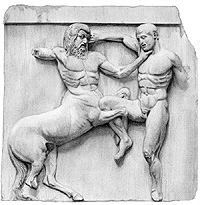In the following encounter we have a middleweight with a lot of skill and speed and heart and bare hands against a heavyweight who can move and has taped hands. The big man should not have been allowed to tape up. The low lead guard by the middleweight makes sense since one big right from his opponent’s taped hand could wreck his ribcage and his head movement is good. He also diverts his jabs to intercept right hands.
I really do like their movement. If this is a knife fight the man in blue murders the big man quick. Note how the man in blue uses safety jabs on a weak pivot to cutoff the straight rights and crosses of the big man. His open-side movement is also good and is what walks his man into his straight right, which comes up a little short due mostly to his shorter arms.
Towards the end you see the big man begin to hunch his shoulders as his eye closes, then the man in blue cuts to the body with a jab, indicating that he no longer fears significant head blows and is ready to level change on his man and put him down. That, to the practiced eye, is the beginning of the end. The old men seconding the fight did not want to see the big fellow get taken apart and cut down, so stepped in and called it. I'm not saying he had it in the bag, but that the tide was turning, he knew it and was going on the hunt and the old men overseeing the fight seem to have a vested interest in calling draws to keep the peace. His body work is good and straight throughout.
When throwing gloveless punches you want the palm facing down any time you go under the elbows and the thumb up or palm up when you are going over his wrists with probing punches. The only palm-down punches you should throw over his guard are punches that have been setup that he’s not going to catch coming in and snap your thumb as you turn the punch over.
If you are getting handled in one of these fights go to the wing block and break his thumbs and knuckles. If he goes to the body without turning his palms down—like some American gloved boxer—let him have at it and drop your elbows on his thumbs.
In the still widow below you see the big man throwing a right hand that is not fully extended. He threw it too soon and it is already going off track due to the shifty sucker he is trying to nail turning with the punch, so there is no sense in following through further, as that would just set him up for a counter. The best thing he can do from here is jab.











Great fight. What do you mean when you stated he diverted his jabs to intercept right hands?
It is hard to see as the camera work had only one angle. But notice that the big man often throws his right as the small man throws his rising jab, which isn't scoring. The jab isn't scoring because he's letting it rise too high and too short and catching the inside of the big man's arm with the outside of his as he is turning on his heel. Rising jabs and shovel hooks can both be diverted into what we call in stick-fighting a beat, but is in boxing called a safety punch or cutoff punch. The entire art of Bruce Lee's Jeet Kune Do [Way of the Intercepting Fist] was based on this concept.